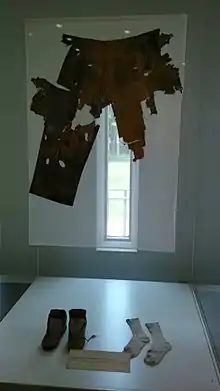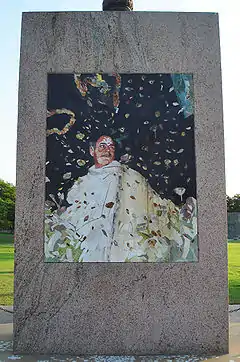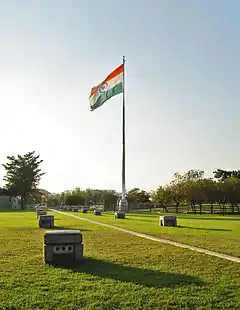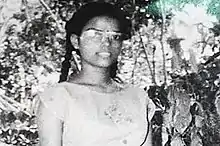Assassination of Rajiv Gandhi
The assassination of Rajiv Gandhi, former Prime Minister of India, occurred as a result of a suicide bombing in Sriperumbudur, Chennai, in Tamil Nadu, India on 21 May 1991.[2] At least 14 others, in addition to Rajiv Gandhi, were killed.[3] It was carried out by Thenmozhi Rajaratnam (also known as Kalaivani Rajaratnam or Dhanu),[1][4] a member of the Liberation Tigers of Tamil Eelam (LTTE). At the time, India had just ended its involvement, through the Indian Peace Keeping Force, in the Sri Lankan Civil War. Subsequent accusations of conspiracy have been addressed by two commissions of inquiry and have brought down at least one national government.[5][6]
| Assassination of Rajiv Gandhi | |
|---|---|
 Seven pillars surround the site of the blast, at the Rajiv Gandhi Memorial in Sriperumbudur | |
| Location | Sriperumbudur, Tamil Nadu, India |
| Date | 21 May 1991 10:10 pm (IST) |
| Target | Rajiv Gandhi |
Attack type | Suicide bombing |
| Weapons | RDX explosive-laden belt |
| Deaths | 15 |
| Injured | 43 |
| Victims | Rajiv Gandhi and at least 57 others |
| Perpetrator | Thenmozhi Rajaratnam (also known as Kalaivani Rajaratnam,[1] also known as Dhanu) |


Assassination
Rajiv Gandhi was campaigning for the upcoming elections along with G.K. Moopanar in southern states of India. On 21 May, after campaigning in Visakhapatnam, his next stop was Sriperumbudur, Tamil Nadu. About two hours after arriving in Madras (now Chennai), Gandhi was driven by motorcade in a white Ambassador car to Sriperumbudur, stopping along the way at a few other election campaigning venues.[7] When he reached a campaign rally in Sriperumbudur, he left his car and began walking towards the dais where he was to deliver a speech. Along the way, he was garlanded by many well-wishers, Congress party workers and school children. The assassin, Dhanu (Thenmozhi Rajaratnam), approached and greeted him. She then bent down to touch his feet and detonated an RDX explosive-laden belt tucked below her dress at exactly 10:10 PM.[8] Gandhi, his assassin and 14 others were killed in the explosion that followed, along with 43 others who were grievously injured. The assassination was caught on film by a local photographer, Haribabu[9] whose camera and film was found intact at the site despite him also dying in the blast.[1]
Victims
13 Indians were killed in the assassin's blast on 21 May 1991.[10][11][12][13][1]
Their names are:
- Rajiv Gandhi: Former Prime Minister of India.
- Dharman: Police constable.
- Santhani Begum: Mahila Congress Leader.
- Rajguru: Police inspector.
- Chandra: Police constable.
- Edward Joseph: Police inspector.
- KS Mohammed Iqbal: Superintendent of police.
- Latha Kannan: Mahila Congress worker.
- Darryl Jude Peters: Attendee and observer.
- Kokilavani: Ten-year-old daughter of Latha Kannan.
- Munuswamy: Former member of the Tamil Nadu Legislative Council.
- Saroja Devi: 17-year old college student.
- Pradeep K Gupta: Personal security officer of Rajiv Gandhi.
Around forty-three bystanders including police sub-inspector Anusata Daisy were also injured in the explosion.[14]
Security lapses
The Supreme Court held that the decision to eliminate Gandhi was precipitated by his interview to Sunday magazine (21–28 August 1990), where he stated that he would send the IPKF to disarm the LTTE if he returned to power. Gandhi also defended the signing of the Indo-Sri Lanka accord in the same interview. The LTTE decision to kill him was perhaps aimed at preventing him from coming to power again. Thereafter, the Justice J S Verma Commission was formed to look into the security lapses that contributed to the killing.
The final report, submitted in June 1992, concluded that the security arrangements for the former PM were adequate but that the local Congress party leaders disrupted and broke these arrangements.[15]
The Narasimha Rao government initially rejected Verma's findings but later accepted it under pressure. However, no action was taken on the recommendations of the commission.
Despite no action, the findings raised vital questions that have previously been consistently raised by political analysts. Sources have indicated that Gandhi was repeatedly informed that there was a threat to his life and that he should not travel to Tamil Nadu. In fact, the then governor of Tamil Nadu Bhism Narayan Singh, broke official protocol and twice warned Gandhi about the threat to his life if he visited the state.
Dr Subramanian Swamy said in his book, Sri Lanka in Crisis: India's Options (2007), that an LTTE delegation had met Rajiv Gandhi on 5 March 1991. Another delegation met him around 14 March 1991 in New Delhi.
Journalist Ram Bahadur Rai wrote that:
The message conveyed to Rajiv Gandhi by both these delegations was that there was no threat to his life and that he can travel to Tamil Nadu without fearing for his life. I did a series of articles after his assassination that pointed out how, after these meetings, Rajiv became complacent about his security and broke security rules in more than 40 rallies.[16]
Funeral

Following his assassination, Rajiv Gandhi's mutilated body was airlifted to New Delhi. From the Palam airport, his body was sent to the All India Institute of Medical Sciences in New Delhi for an autopsy, reconstruction and embalming.[17]
A state funeral was held for Rajiv Gandhi on 24 May 1991. His funeral was broadcast live nationally and internationally, and was attended by dignitaries from over 60 countries.[18] He was cremated on the banks of the river Yamuna, near the cremation spot of his mother, brother and grandfather. Today, the site where he was cremated is known as Veerbhumi.
Investigation
Immediately after the assassination, the Chandrasekhar government handed the investigation over to the CBI on 22 May 1991. The agency created a special investigation team under D. R. Karthikeyan[19] to determine who was responsible for the assassination. The SIT probe confirmed the role of the LTTE in the assassination,[20] which was upheld by the Supreme Court of India.[21]
The interim report of Justice Milap Chand Jain, looking into the conspiracy angle to the assassination, indicted the DMK for colluding with the LTTE. The report concluded that the DMK had provided sanctuary to the LTTE, which made it easier for the rebels to assassinate Rajiv Gandhi.[21]
The Commission report stated that the year 1989 signified "the perpetuation of the general political trend of indulging the Tamil militants on Indian soil and tolerance of their wide-ranging criminal and anti-national activities". The report also alleged that LTTE leaders in Jaffna were in possession of sensitive coded messages exchanged between the Union government and the state government of DMK. "There is evidence to show that, during this period, some of the most vital wireless messages were passed between the LTTE operatives based in Tamil Nadu and Jaffna. These messages, which were decoded later, are directly related to the assassination of Rajiv Gandhi", the report stated. The Congress subsequently brought down the United Front (UF) government of I K Gujral after the report was leaked in November 1998. The party also demanded the removal of DMK from the UF government, arguing that it had played a key role in the death of Rajiv Gandhi.
Perpetrator

The assassination was carried out by Thenmozhi Rajaratnam, also known as Dhanu, also known as Kalaivani Rajaratnam.[1] She was a member of the Sri Lankan Tamil militant group Liberation Tigers of Tamil Eelam (Tamil Tigers). Thenmozhi was the daughter of a Sri Lankan Tamil man named Rajaratnam. Rajaratnam had predeceased Thenmozhi by sixteen years. Thenmozhi was survived by her mother, brother Sivavarman and two sisters.[1] Thenmozhi was 17 years old when she carried out the assassination.
The court convicted and sentenced the seven persons who facilitated the assassination of Rajiv Gandhi to life imprisonment. They are currently undergoing life imprisonment in prisons in India. They are:
- Santhan alias T. Suthenthiraraja - a Sri Lankan national.
- Nalini - an Indian citizen. Nalini is the wife of Murugan (alias Sriharan).
- Murugan alias Sriharan - a Sri Lankan national.
- A.G. Perarivalan.
- Robert Pious - a Sri Lankan national.
- Jayakumar - the brother in law of Robert Pious.
- Ravichandran - a Sri Lankan national.[22]
Supreme Court judgment
As per the Supreme Court of India judgment, by Judge K. T. Thomas, the killing was carried out due to personal animosity of the LTTE chief Prabhakaran towards Rajiv Gandhi. Additionally, the Rajiv Gandhi administration had antagonised other Tamil militant organisations like PLOTE for reversing the military coup in Maldives back in 1988.[23]
The judgement further cited the death of Thileepan in a hunger strike and the suicide by 12 LTTE cadres in a vessel in October 1987. While convicting the accused, four of them to death and others to various jail terms, the judgment stated that no evidence existed that any one of the conspirators ever desired the death of any Indian other than Rajiv Gandhi, though several others were killed. Judge Wadhwa further stated there was nothing on record to show that the intention to kill Rajiv Gandhi was to overawe the government. Hence it was held that it was not a terrorist act under TADA (Act).[24][25] Judge Thomas further stated that conspiracy was hatched in stages commencing from 1987 and that it spanned several years. The special investigation team of India's premier special investigation agency Central Bureau of Investigation was not able to pinpoint when the decision to kill Rajiv Gandhi was taken.[25]
Trial
The trial was conducted under the Terrorist and Disruptive Activities Act. On 28 January 1998, the designated TADA court in Chennai gave death sentences to all the 26 accused.[26][27] This created a storm in India. Legal experts were divided.[28] Human rights groups protested that the trial did not meet the standards of a free trial.[29] The trial was held behind closed doors, in camera, and the identity of witnesses was not disclosed. Ms A. Athirai, an accused, was 17 years old when she was arrested.
Under the TADA an accused can appeal only to the Supreme Court. Appeal to the High Court is not allowed as in normal law.[30] Confessions given by the accused to the Superintendent of Police are taken as evidence against the accused under TADA. Under TADA the accused could be convicted on the basis of evidence that would have been insufficient for conviction by an ordinary court under normal Indian law. In the Rajiv Gandhi case, confessions by the accused formed a major part of the evidence in the judgement against them which they later claimed was taken under duress.[31]
On appeal to the Supreme Court, only four of the accused were sentenced to death and the others to various jail terms. S Nalini Sriharan is the lone surviving member of the five-member squad behind the assassination of Rajiv Gandhi and is serving life imprisonment. Arrested on 14 June 1991, she was sentenced to death, along with the other 25 accused. However, the court confirmed that the death sentence was given to only four of the convicts, including Nalini, on 11 May 1999. Nalini, who is the wife of an LTTE operative known as V Sriharan alias Murugan, another convict in the case who had been sentenced to death, later gave birth to a girl, Harithra Murugan in prison. Upon the intervention of Rajiv Gandhi's widow and Congress president Sonia Gandhi, who petitioned for clemency for the sake of Nalini's daughter in 2000, the death sentence was commuted to life imprisonment. Nalini was treated as a class 'A' convict from 10 September 1999 till the privilege was withdrawn in May 2010 after a mobile phone was allegedly recovered from her cell during a surprise check. She "regrets" the killing of the former Prime Minister and claims that the real conspirators have not been booked yet.[32][33] The President of India rejected the clemency pleas of Murugan and two others on death row, T Suthendraraja alias Santhan and A G Perarivalan alias Arivu in August 2011.[34] The execution of the three convicts was scheduled for 9 September 2011. However, the Madras High Court intervened and stayed their execution for eight weeks based on their petitions. Nalini was shifted back to Vellore prison from Puzhal prison amidst tight security on 7 September 2011. In 2010, Nalini had moved the Madras High Court seeking release as she had served more than 20 years in prison. She argued that even life convicts were released after 14 years. However, the state government rejected her request.[35][36][37] Murugan, Santhan and Perarivalan, the three convicts condemned to death, claimed that they were not ordinary criminals but political prisoners.[38][39][40]
Controversies
In a report published on 30 October 2012 in DNA,[41] K Ragothaman, former chief investigator of the CBI, talks about his new book Conspiracy to Kill Rajiv Gandhi: From the CBI Files and tells the reporter that while the CBI had started a preliminary inquiry in which MK Narayanan, former West Bengal Governor and former Intelligence Bureau director, was named a suspect in hiding evidence, the case was buried by the CBI SIT Chief, D.R. Karthikeyan.
In an interview in 2017, Justice K.T. Thomas had said that "there were serious flaws" in the CBI's investigation in case, particularly related to the seizure of Rs 40 lakh in cash from the convicts, which led him to believe that the probe exposed "an unpardonable flaw" in the "Indian criminal justice system".
Jain Commission and other reports
In the Jain report, various people and agencies are named as suspected of having been involved in the murder of Rajiv Gandhi. Among them, the cleric Chandraswami was suspected of involvement, including financing the assassination.[42][43][44] One of the accused, Ranganath, said Chandraswami was the godfather who financed the killing.[45] Sikh Militants were also suspected.[46][47] The interim report of the Jain Commission created a storm when it accused M. Karunanidhi the former Chief Minister of Tamil Nadu of a role in the assassination, leading to Congress withdrawing its support for the I. K. Gujral government and fresh elections in 1998. Also other strong LTTE sympathizers Vaiko with MDMK and Thol. Thirumavalavan with VCK have supported Congress under Sonia Gandhi in the past. Vaiko left the UPA alliance before the 2009 election, partly due to the Sri Lankan issue. In the 2001 Norway peace talks, Prabhakaran told the press that the assassination of Rajiv Gandhi was a sorrowful event. In 2006, LTTE spokesman Anton Balasingham told the Indian television channel NDTV that the killing was a "great tragedy, a monumental historical tragedy which we deeply regret".[48][49]
Memorial and popular culture
- The Rajiv Gandhi Memorial as built on the site, and is one of the major tourist attractions in the small industrial town.
- Assassination of Rajiv Gandhi: Unanswered Questions and Unasked Queries by Subramanian Swamy
- Conspiracy to Kill Rajiv Gandhi - from CBI Files by the Central Bureau of Investigation officer and chief investigating officer of the assassination case.[50]
- Beyond the Tigers: Tracking Rajiv Gandhi's Assassination by Rajeev Sharma.[51]
- Bypass: Flaws in the Forensic Investigation of Rajiv Gandhi Murder, the first open source feature film from India.[52][53]
Films
- Kuttrapathirikai, Mission 90 Days, The Terrorist, Cyanide and Madras Cafe are films based on the assassination.
References
- Kaarthikeyan, D. R. (23 June 2015). The Rajiv Gandhi Assassination: The Investigation. ISBN 9788120793088.
- Assassination in India; Rajiv Gandhi is assassinated in bombing at cawmpaign stop; India puts off rest of voting
- "1991: Bomb kills India's former leader Rajiv Gandhi". BBC News. 21 May 1991. Archived from the original on 27 July 2008. Retrieved 5 August 2008.
- "Lady With The Poison Flowers". www.outlookindia.com.
With Rajiv Gandhi's gruesome assassination, the suicide bomber had well and truly arrived
- J. Cooper, Kenneth (29 November 1997). "Leader Of India Falls From Power". www.sun-sentinel.com. Retrieved 3 August 2014.
- "TN to release all Rajiv convicts". Archived from the original on 4 March 2014. Retrieved 19 February 2014.
- "Assassination in India; Rajiv Gandhi is assassinated in bombing at campaign stop", by Barbara Crossette, The New York Times, 22 May 1991. Neena Gopal of the Gulf News of Dubai was also in the car, in the back seat with Chandrashekhar and a local party official. "A Chance To Be Near The People New Campaigning Style Put Gandhi In Crowds" by Barbara Crossette, New York Times, 22 May 1991, via Orlando Sentinel. Retrieved 2010-07-19.
- "A look back at Rajiv Gandhi assassination: Rare images from the past". The New Indian Express.
- Supreme Court of India, State Of Tamil Nadu Through vs Nalini And 25 Others on 11 May 1999
- Rodrigues, Savio. "Rajiv Gandhi was not the only one who died in the bomb-blast on May 21 1991!". Goa Chronicle. Retrieved 30 November 2020.
- "The others who died with Rajiv Gandhi: Families talk of struggle, neglect". The Indian Express. 22 May 2016. Retrieved 30 November 2020.
- "Three reasons why I think the 'assassins of Rajiv Gandhi' should never be freed". www.dailyo.in. Retrieved 30 November 2020.
- Dutta, Prabhash K. (21 May 2017). "Remembering Rajiv Gandhi: What exactly happened on that fateful night of May 21 in Madras and New Delhi". India Today. Retrieved 30 November 2020.
- Peter, Petlee (1 May 2012). "Women Power: Living with grit and painful memories". The Hindu. ISSN 0971-751X. Retrieved 30 November 2020.
- Patel, Tejas. "Rajiv assassination mystery unsolved". Article. NDTV.com. Retrieved 21 May 2011.
- Patel, Tejas. "Rajiv assassination mystery unsolved". Article. Asian Tribune. Retrieved 21 May 2011.
- Ahluwalia, Meenakshi (January 1991). Assassination of Rajiv Gandhi — Shashi Ahluwalia, Meenakshi Ahluwalia. ISBN 9788170993155. Retrieved 19 January 2013.
- "Assassination of Rajiv Gandhi and its aftermath". Knowledge Hub. 21 May 1991. Archived from the original on 30 April 2013. Retrieved 19 January 2013.
- "Profile of D.R.Karthikeyan". www.thesnacademy.ac.in.
- Subramanian, T.S. "A mystery solved". www.frontline.in. Frontline. Retrieved 10 August 2014.
- Keerthana, R (21 March 2014). "Rajiv's death – a revisit". The Hindu. Retrieved 10 August 2014.
- https://www.firstpost.com/india/rajiv-gandhi-murder-who-are-the-7-convicts-the-tn-govt-wants-to-free-1398193.html
- "Archived copy" (PDF). Archived from the original (PDF) on 2 November 2011. Retrieved 24 May 2017.CS1 maint: archived copy as title (link)
- "Out of the TADA net". The Hindu. Chennai, India.
- "Death Reference Case No. (@ D.NO.1151 of 1998)" (PDF). Cbi.nic.in. Retrieved 3 August 2014.
- "Rajiv Gandhi assassination case: tracing the trial". Ibnlive.in.com. Retrieved 3 August 2014.
- "Rajiv Gandhi assassination Timeline". Dailypioneer.com. 20 February 2014. Retrieved 3 August 2014.
- Bhavna Vij & Swati Chaturvedi (30 January 1998). "Legal luminaries divided on death verdict in Rajiv assassination case". The Indian Express. Retrieved 30 August 2013.
- India: The Prevention of Terrorism Bill. Past abuses revisited | Amnesty International Archived 3 December 2006 at the Wayback Machine
- "Human Rights Bulletin on Srfati Lanka". Derechos.org. Retrieved 3 August 2014.
- "In the Supreme Court of India – Criminal Appellate Jurisdiction". cbi.nic.in. Archived from the original on 22 January 2007.
- "I regret Rajiv Gandhi's assassination: Nalini". The Times of India. PTI. 3 August 2008. Retrieved 30 August 2013.
- "My sins washed away, says Nalini Sriharan". DNA India. IANS. 16 April 2008. Retrieved 30 August 2013.
- "Nalini meets hubby on death row". The Times of India. TNN. 11 September 2011. Retrieved 30 August 2013.
- "Rajiv Gandhi assassin Nalini Sriharan not to be freed". India Today. 29 March 2010. Retrieved 30 August 2013.
- "Rajiv Gandhi's assassin Nalini gets back 'A' class jail facilities". The Times of India. TNN. 16 March 2012. Retrieved 30 August 2013.
- "Rajiv Gandhi's killer Nalini breaks down". NDTV. 7 September 2011. Retrieved 30 August 2013.
- "Nalini Sriharan back in Vellore". DNA India. 7 September 2011. Retrieved 30 August 2013.
- "Nalini shifted from Vellore jail to Puzhal". The Times of India. 29 June 2010. Retrieved 30 August 2013.
- A Subramani (21 January 2010). "After 19 yrs in jail for Rajiv murder, Nalini may be freed". The Times of India. TNN. Retrieved 30 August 2013.
- http://www.dnaindia.com/india/report_ib-hid-crucial-video-on-rajiv-gandhi-murder-book_1757684
- outlookindia.com Archived October 15, 2007, at the Wayback Machine
- "Probe Chandraswami's role in Rajiv case - Jain report". Expressindia.com. 23 September 1987. Retrieved 3 August 2014.
- "CBI sees godman's role in Rajiv's killing". www.deccanherald.com. Archived from the original on 28 December 2004.
- "Chandraswami had a hand in the plot". Expressindia.com. 14 May 1999. Retrieved 3 August 2014.
- Jain Commission Report Chapter Ii Archived September 29, 2007, at the Wayback Machine
- Jain Commission Report Chapter Viii Archived August 15, 2006, at the Wayback Machine
- We deeply regret Rajiv's death: LTTE Archived 13 May 2007 at the Wayback Machine
- "Tamil Tiger 'regret' over Gandhi". BBC News. 27 June 2006. Retrieved 5 August 2008.
- Manoj Mitta, TNN (30 October 2012). "Rajiv Gandhi assassination video suppressed, claims book". The Times of India. Retrieved 4 September 2013.
- "LTTE's messages show why Gandhi's murder should be re-probed (Part-1)". Firstpost. Retrieved 3 August 2014.
- "Bypass Film". Bypass Team.
- "Bypass Film". Bypass Team.
Further reading
- State of Tamil Nadu through Superintendent of police, CBI/SIT v/s Nalini and 25 others.[1]
- Blakeslee, David S. "Politics and public goods in developing countries: Evidence from the assassination of Rajiv Gandhi." Journal of Public Economics 163 (2018): 1-19 online.
- Gopal, Neena. The Assassination of Rajiv Gandhi (Penguin Random House India, 2017).
- Harish M, The Assassination of Rajiv Gandhi & Involvement of Sikh Extremists (2020) excerpt
- Kaarthikenyan, D. R., and Radhavinod Raju. Rajiv Gandhi Assassination (Sterling Publishers Pvt. Ltd, 2008). online
- Roberts, Michael. "Killing Rajiv Gandhi: Dhanu's sacrificial metamorphosis in death." South Asian History and Culture 1.1 (2009): 25-41 online.
- Rudolph, Lloyd I. "Why Rajiv Gandhi’s Death Saved the Congress: How an Event Affected the Outcome of the 1991 Election in India." in India Votes (Routledge, 2019) pp. 436-454.